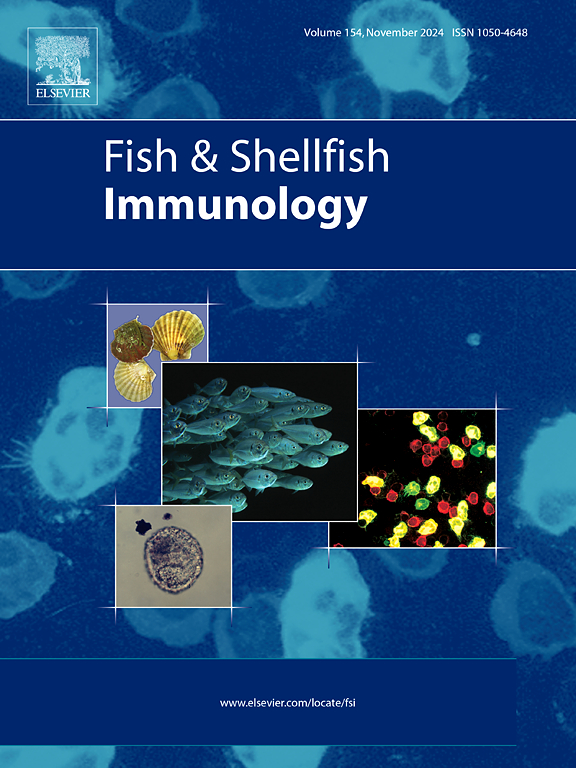Protective effects of inactivated SPIV vaccine in sea perch (Lateolabrax japonicas) by intraperitoneal injection and immersion immunization
IF 3.9
2区 农林科学
Q1 FISHERIES
引用次数: 0
Abstract
Sea perch is one of the most important fish species farmed in China. However, the frequent outbreak of viral diseases induced by sea perch iridovirus (SPIV) always caused high mortality and heavy economic losses in sea perch aquaculture. Up to now, no effective countermeasures against SPIV infection have been established. Here, the inactivated SPIV combined with ISA 763B VG (SPIV/763B) or IMS 1312 VG (SPIV/1312) were used for injection and immersion immunization, respectively. The potential immunoprotective effects of vaccines against SPIV infection were evaluated after the safety test of vaccines. Following challenge with SPIV, fish vaccinated with SPIV/763B or SPIV/1312 by injection or immersion exhibited high protection efficacy against SPIV compared to PBS group, with a relative percent survival (RPS) of 81.7 % and 63.7 %, respectively. The vaccinated groups also showed a significant reduction in both viral load and mRNA levels of viral genes in different tissues. Additionally, the number of basophilic hypertrophied cells induced by SPIV was dramatically decreased in the vaccinated groups. Moreover, the specific serum antibody was detected from 7 days post-vaccination and the transcription levels of innate immune-related genes (IRF3, IRF7, ISG15, Mx-2, MyD88) and adaptive immune-related gene (IgM) were differently up-regulated in SPIV/763B or SPIV/1312 vaccinated groups compared to the control group. Taken together, our results indicated that the combination of inactivated SPIV with different adjuvants could provide effective protection against SPIV infection in sea perch via activation of both humoral and cell-mediated immune responses.
SPIV灭活疫苗腹腔注射和浸泡免疫对日本鲈鱼的保护作用。
海鲈是中国最重要的养殖鱼类之一。然而,由海鲈虹膜病毒(SPIV)引起的病毒性疾病的频繁爆发,给海鲈养殖业造成了很高的死亡率和巨大的经济损失。到目前为止,还没有针对SPIV感染的有效对策。本研究将灭活的SPIV分别与ISA 763B VG (SPIV/763B)和IMS 1312 VG (SPIV/1312)联合进行注射和浸泡免疫。通过疫苗安全性试验,评价疫苗对SPIV感染的潜在免疫保护作用。在SPIV攻击后,与PBS组相比,注射或浸泡接种SPIV/763B或SPIV/1312疫苗的鱼对SPIV的保护效果较高,相对存活率(RPS)分别为81.7%和63.7%。接种疫苗组在不同组织中的病毒载量和病毒基因mRNA水平也显著降低。此外,接种疫苗组SPIV诱导的嗜碱性肥大细胞数量显著减少。此外,接种后7 d检测特异性血清抗体,与对照组相比,SPIV/763B或SPIV/1312接种组的先天免疫相关基因(IRF3、IRF7、ISG15、Mx-2、MyD88)和适应性免疫相关基因(IgM)的转录水平有所上调。综上所述,我们的研究结果表明,将灭活的SPIV与不同的佐剂联合使用,可以通过激活体液和细胞介导的免疫反应,有效地保护海鲈免受SPIV感染。
本文章由计算机程序翻译,如有差异,请以英文原文为准。
求助全文
约1分钟内获得全文
求助全文
来源期刊

Fish & shellfish immunology
农林科学-海洋与淡水生物学
CiteScore
7.50
自引率
19.10%
发文量
750
审稿时长
68 days
期刊介绍:
Fish and Shellfish Immunology rapidly publishes high-quality, peer-refereed contributions in the expanding fields of fish and shellfish immunology. It presents studies on the basic mechanisms of both the specific and non-specific defense systems, the cells, tissues, and humoral factors involved, their dependence on environmental and intrinsic factors, response to pathogens, response to vaccination, and applied studies on the development of specific vaccines for use in the aquaculture industry.
 求助内容:
求助内容: 应助结果提醒方式:
应助结果提醒方式:


